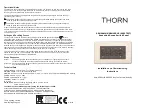
2-15
Figure2-13 Connecting the grounding cable to a grounding strip
(1) Grounding post
(2) Grounding strip
(3) Grounding cable
(4) Hex nut
Grounding the switch with a grounding conductor buried in
the earth ground
If the installation site does not have grounding strips, but earth ground is available, hammer a 2.5 m
(8.20 ft) or longer angle iron or steel tube into the earth ground to act as a grounding conductor. Make
sure a minimum of 0.7 m (2.30 ft) is left between the top of the grounding conductor and the ground.
In cold areas, bury the grounding conductor below the frozen soil layer. In areas with thin soil or rocky
gravel, determine the depth for burying the grounding conductor based on the actual condition.
If zinc-coated steel is used, the following dimensions requirements must be met:
•
Angle iron
—A minimum of 50 × 50 × 5 mm (1.97 × 1.97 × 0.20 in).
•
Steel tube
—A minimum of 3.5 mm (0.14 in) in thickness.
•
Flat steel
—A minimum of 40 × 4 mm (1.57 × 0.16 in).
•
Round steel
—A minimum of 10 mm (0.39 in).
Weld the yellow-green grounding cable to the angel iron or steel tube and treat the joint for corrosion
protection.
Figure2-14 Grounding the switch by burying the grounding conductor into the earth ground
(1) Grounding screw
(2) Grounding cable
(3) Earth
(4) Joint
(5) Grounding conductor
(6) Chassis rear panel
1
2
3
4
1
2
5
4
3
6







































